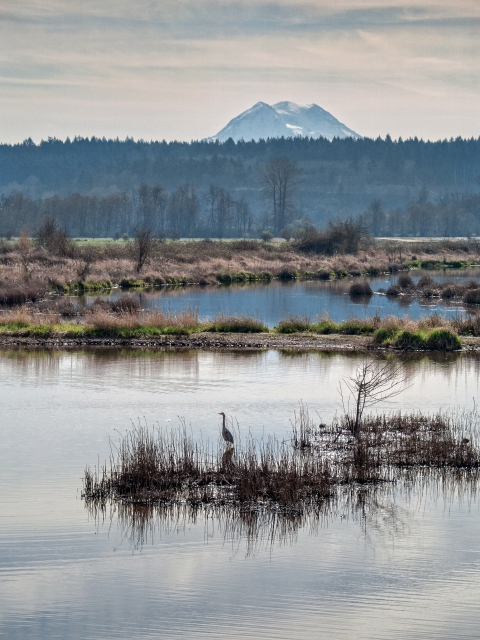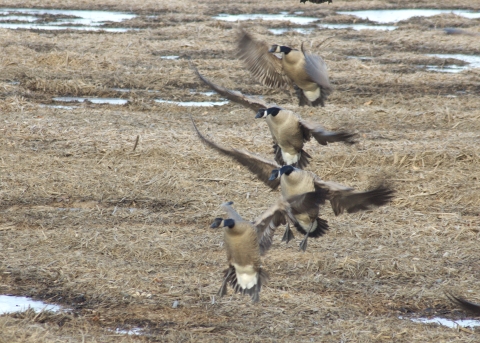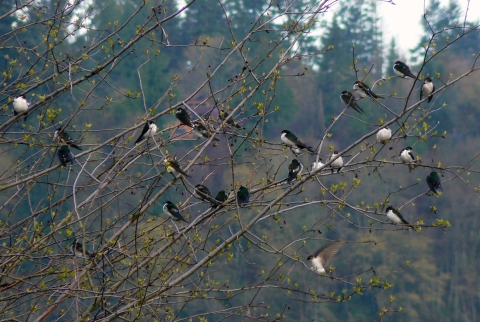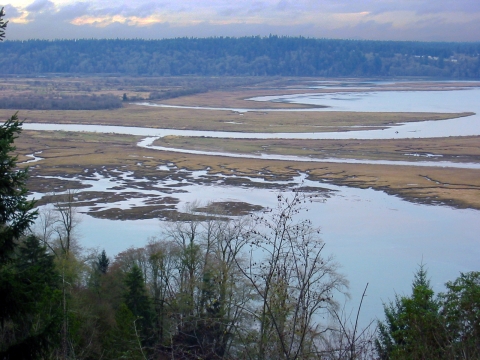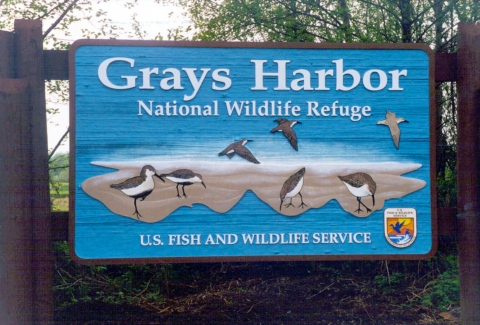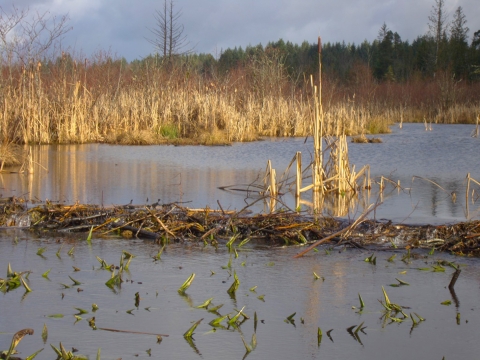About Us
In 1974, in recognition of the area's unique fish and wildlife resources, Billy Frank Jr. Nisqually National Wildlife Refuge was established with approval by the Migratory Bird Conservation Commission. The refuge protects the Nisqually River Delta, a vital place for migratory birds and salmon as well as resident wildlife.
Congress approved a boundary within which land for the refuge may be acquired. The refuge currently has fee title to approximately 2,925 acres of the 7,415 acres within the approved boundary. Legal authorities used for the establishment of the refuge include the Migratory Bird Conservation Act and Fish and Wildlife Act of 1956.
The refuge plays an increasingly important role in the protection of the Nisqually River Delta and the lower Nisqually River watershed. The refuge is a diverse mosaic of habitats, including salt marsh salt marsh
Salt marshes are found in tidal areas near the coast, where freshwater mixes with saltwater.
Learn more about salt marsh , marine waters, riparian riparian
Definition of riparian habitat or riparian areas.
Learn more about riparian forest, freshwater wetlands, grassland, and upland forest. It has international significance as a staging area, sanctuary, and migration stopover for migratory birds of the Pacific Flyway. The refuge also has regional importance as migration and rearing habitat for salmon, particularly the Nisqually River run of the federally-listed Nisqually Chinook salmon.
But this refuge has not remained unchanged. One of the largest restoration efforts in Puget Sound returned diked farmland back to its original saltwater mudflat. The transformation of the landscape from a century of farmland back to a productive wetland is ongoing. This is a living laboratory, revealing how an ecosystem can heal.
This slice of wildness is sandwiched between the state capital and a military base, its approved boundary bisected by Interstate 5. Yet it supports a wide range of wildlife and draws photographers, students, and other visitors to view the changing seasons, swinging tides, and shifting populations of plants and animals.
Our Mission
The mission of the National Wildlife Refuge System is to administer a national network of lands and waters for the conservation, management, and, where appropriate, restoration of the fish, wildlife, and plant resources and their habitats within the United States for the benefit of present and future generations of Americans.
Every national wildlife refuge national wildlife refuge
A national wildlife refuge is typically a contiguous area of land and water managed by the U.S. Fish and Wildlife Service for the conservation and, where appropriate, restoration of fish, wildlife and plant resources and their habitats for the benefit of present and future generations of Americans.
Learn more about national wildlife refuge was created for a special purpose. Some were created to protect migratory birds, others to protect threatened or endangered species or unique habitats, while others fulfill another special purpose. All activities allowed on refuges must be evaluated to make sure no activity will conflict with the reason the refuge was founded. Billy Frank Jr. Nisqually National Wildlife Refuge was established with the following purposes:
- "...for use as an inviolate sanctuary, or for any other management purpose, for migratory birds" 16 U.S.C. 715d, Migratory Bird Conservation Act;
- "...for the development, advancement, management, conservation, and protection of fish and wildlife resources..." 16 U.S.C. 742f(a)(4); and
- "...for the benefit of the United States Fish and Wildlife Service, in performing its activities and services. Such acceptance may be subject to the terms of any restrictive or affirmative covenant, or condition of servitude" 16 U.S.C 742f(b)(1).
Our History
Because the Nisqually Delta is close to two major urban centers, Tacoma and Olympia, it has faced numerous development threats over the years, including proposals for a deep-water port facility, an aluminum mill, and a landfill. Largely as a result of citizen efforts led by conservationist and teacher Margaret McKenny and the Nisqually Delta Association, these proposals were denied. In 1966 and 1967, the Washington Department of Fish and Wildlife purchased approximately 616 acres of delta tidelands and salt marshes to stave off development. A Nisqually River Task Force was created to assist in preserving and protecting the river and delta.
In 1971, in recognition of the significance of the area as a natural estuarine and aquatic ecosystem, the U.S. Department of the Interior designated the estuarine portion of the Nisqually River Delta as a National Natural Landmark National Natural Landmark
The National Natural Landmarks Program preserves sites illustrating the geological and ecological character of the United States. The program aims to enhance the scientific and educational value of the preserved sites, strengthen public appreciation of natural history and foster a greater concern for the conservation of the nation’s natural heritage. The program was established in 1962 by administrative action under the authority of the Historic Sites Act of 1935. The first National Natural Landmarks were designated in 1963. Today, there are more than 600 National Natural Landmarks in 48 states, American Samoa, Guam, Puerto Rico and the U.S. Virgin Islands.
Learn more about National Natural Landmark . In 1972, the Task Force recommended the delta be set aside as a national wildlife refuge national wildlife refuge
A national wildlife refuge is typically a contiguous area of land and water managed by the U.S. Fish and Wildlife Service for the conservation and, where appropriate, restoration of fish, wildlife and plant resources and their habitats for the benefit of present and future generations of Americans.
Learn more about national wildlife refuge .
In February 1974, in recognition of the area's unique fish and wildlife resources, the Brown Farm property and tidelands were acquired for inclusion in the National Wildlife Refuge System as Nisqually National Wildlife Refuge. This initial purchase included 1,285 acres of diked grasslands, freshwater marshes, and tidelands funded by the Migratory Bird Conservation Commission under the authority of the Migratory Bird Conservation Act. Three other funding sources include appropriations authorized by the Wetlands Loan Act, import duties collected on arms and ammunition, and receipts from the sale of refuge admission permits.
On December 18, 2015, the refuge was renamed to honor Billy Frank, Jr., a Nisqually Tribal leader (Public Law 114-101).
Significant Dates
10,000 years ago - The Squalli-Absch (Nisqually) people cross the Cascade Mountains and settled in the Nisqually River watershed.
1775 - The first European ship, the Santiago, lands on Washington's coast, introducing smallpox. 30% of the Northwest Coast's indigenous population is wiped out from smallpox. This and other introduced diseases reduces the indigenous population of North and South America by 90%.
1846 - George Shaser settles in the Nisqually Delta.
August 14, 1846 - Congress ratifies the Oregon Territory.
March 2, 1853 - Washington Territory is split from Oregon Territory.
March 17, 1853 - Isaac Stevens is appointed Governor and Superintendent of Indian Affairs for Washington Territory.
December 24-26, 1854 - Stevens and nine tribes gather to hear the terms of the Medicine Creek Treaty.
October 1855 - Medicine Creek Treaty Tribes are at war over terms of the treaty. Changes are made.
1872 - George Shannon acquires Shaser's delta property and begins building a dike.
1884 - The Nisqually reservation is divided into 30 family allotments on both sides of the Nisqually River.
November 11, 1889 - Washington becomes the 42nd state.
1896 - Ole Braget purchases 420 acres of delta land east of the Nisqually River.
1904 - Alson Lennon Brown purchases 2,300 acres of delta land between the Nisqually River and McAllister (Medicine) Creek.
1918 - The federal government condemns 70% of the Nisqually Reservation to form Camp Lewis (today's Joint Base-Lewis McChord).
1919 - Brown loses the farm to creditors.
March 9, 1931 - Billy Frank, Jr., is born.
1932 - The Twin Barns are built, replacing barns that burned in 1929.
1945 - Billy Frank, Jr., is first arrested for fishing at age 14. He will be arrested more than 50 times for exercising his right to fish.
1950s-1960s - Nisqually Delta is targeted for industrial purposes by cities and corporations.
1965 - Margaret McKenny and other leaders begin to organize to protect the Nisqually Delta from industrialization.
1950-1970 - Native people are regularly beaten and arrested for fishing. "Fish-ins" are held in protest.
1970 - The Puyallup Tribe holds a fish-in that leads to the seminal case United States v. State of Washington.
June 1971 - National Natural Landmark Designation: The Nisqually Delta was added to the National Park Service's Registry of Natural Landmarks in June 1971. The designation was based on its significance as one of the best examples of a nationally representative river delta and estuarine ecosystem. The Delta supports one of the five highest quality known examples of Washington and Oregon salt marshes. The 4,404-acre landmark includes public and private ownerships of land, including lands of the National Audubon Society and Washington Department of Fish and Wildlife.
1974 - Judge George Boldt decides United States v. State of Washington in favor of the tribes.
Jan. 22, 1974 - Establishment of Nisqually National Wildlife Refuge
1989 - Designation of the Research Natural Area: located at the mouth of the Nisqually River, the 793-acre Nisqually Delta Research Natural Area was established with the following objectives: 1) preserve and protect the Delta as a significant natural ecosystem; 2) serve as a gene pool for the preservation of native and endangered species; and 3) provide educational and research areas for the study of scientific aspects, including successional trends. Management activities that modify or alter natural ecological processes, including consumptive uses, are not allowed in Research Natural Areas.
1999 - New visitor center and boardwalks are constructed.
1999 - Friends of Nisqually National Wildlife Refuge is created.
2001 - Kenny Braget sell his farm to the Nisqually Tribe.
Nov. 11, 2009 - Completion of the largest estuary restoration project in the Pacific Northwest. In partnership with the Nisqually Indian Tribe and Ducks Unlimited, Inc., the Brown Farm Dike (constructed around 1909) is removed, returning 762 acres of estuary back to tidal influence.
February 1, 2011 - The one-mile Estuary Boardwalk is opened, reaching out as far as where the Brown Farm Dike did.
May 5, 2014 - Billy Frank, Jr., dies at age 83.
Dec. 18, 2015 - The refuge changes its name from Nisqually National Wildlife Refuge to Billy Frank Jr. Nisqually National Wildlife Refuge in honor of Billy Frank Jr., a Nisqually Tribal leader and Native American spokesman for Tribal rights (Billy Frank Jr. Tell Your Story Act, PL 114-101). Congress also establishes the Medicine Creek Treaty Memorial.
Other Facilities in this Complex
Nisqually National Wildlife Refuge Complex is comprised of three refuges in western Washington.
Grays Harbor National Wildlife Refuge
Located in Hoquiam, Washington, approximately 56 miles west of Olympia, the refuge is known for large concentrations of migratory shorebirds, especially in spring months as they travel north to breeding grounds. The Grays Harbor estuary was designated a hemispheric reserve by the Western Hemisphere Shorebird Reserve network and is one of six major stopover areas between Alaska and South America. The Sandpiper Trail is open year-round and offers closer views to witness hundreds of thousands of shorebirds foraging, resting, and evading aerial predators.
Black River Unit of Nisqually National Wildlife Refuge Complex
Located southwest of Olympia, the unit was established to protect the Black River watershed for biological diversity. We enhance and manage unique wetland and riparian riparian
Definition of riparian habitat or riparian areas.
Learn more about riparian ecosystems for the benefit of anadromous salmonid production and rearing, for migratory and resident birds, and for other wetland-dependent wildlife. Read the Comprehensive Conservation Plan for more information.
